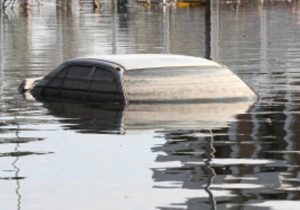
As cleanup from the devastating floods throughout the Carolinas continues, there’s a new hazard to consider for used car buyers, according to AAA Carolinas. Buyers need to know how to avoid purchasing a vehicle that may look great, but could be secretly suffering from flood damage.
In many cases, insurance companies total flood damaged vehicles which are then sold to salvage companies. However, rather than being disassembled for parts, some of these vehicles end up being purchased by individuals who restore them to operating condition-with varying levels of expertise. AAA Carolinas warns car buyers that flood-damaged vehicles will often continue to appear in the marketplace for many months following a major flood.
“Fresh paint, new upholstery and that ‘new-car smell’ can mask flood damage,” said Greg Pence, Auto Buying Manager for AAA Carolinas. “While services like CarFax can be a good resource for buyers, the only true way of knowing whether a vehicle has suffered flood damage is to have a certified mechanic inspect the vehicle.”
The best protection against buying a flood-damaged vehicle is a thorough pre-purchase inspection by a qualified shop such as an AAA Approved Auto Repair facility. Nearby locations can be found at AAA.com/Repair. As part of their inspection, the shop will look for common indicators of flood damage.
Tips on How to Spot a Flood-Damaged Vehicle:
- Engage your sense of smell to detect any damp or musty odors inside the vehicle.
- Are the windows fogged up? Has the carpet or upholstery been replaced or recently shampooed? Pull back the carpet at different areas and look for mud, dirt or signs of water stains.
- Inspect the dashboard underside for signs of mud and dirt. This is a particularly hard area to clean.
- Look under the vehicle for corrosion. It is uncommon to find corrosion in newer vehicles and those that are owned or sold in southern states.
- Open all doors, hood, and trunk to inspect for corrosion, mud and dirt or discoloration on the door frames, hinges and under the weather stripping. Pay special attention to small spaces and crevices that are difficult to clean.
- Check all warning lights, window motors, and all electrical components to ensure they are working properly. While a non-working part alone does not mean the vehicle was flooded, it combined with other difficulties is a cause for concern.
Another good practice that can help prospective buyers avoid flood-damaged cars and trucks is the purchase of a vehicle history report. While such reports don’t always catch everything, more often than not they will indicate when a vehicle has been in a flood or been issued a salvage title, indicating a major problem in its past.
For more information on purchasing a vehicle through AAA visit AAA.com/autobuying.





















Recent Comments